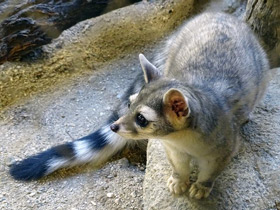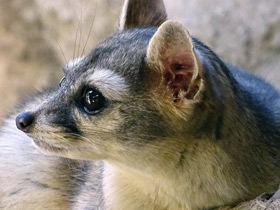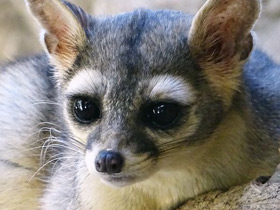The genus Bassariscus
Bassariscus is a genus in the family Procyonidae. There are two extant species in the genus: the ringtail or ring-tailed cat (Bassariscus astutus) and the cacomistle (Bassariscus sumichrasti). Genetic studies have indicated that the closest relatives of Bassariscus are raccoons, from which they diverged about 10 million years ago in the Tortonian Age of the Miocene. The two lineages of Bassariscus are thought to have separated after only another two million years, making it the extant procyonid genus with the earliest diversification. Later diversification in the genus in the Pliocene and Pleistocene saw the emergence of two extinct species, Bassariscus casei and Bassariscus sonoitensis, respectively. Due to the more digitigrade stance of their legs compared to the plantigrade stance of other members of Procyonidae, some taxonomies place the genus as a separate family, Bassaricidae.. The name is a Greek word for fox ("bassaris") with a Latinized diminutive ending ("-iscus"). The genus was named by Elliott Coues in 1887, having previously been described by Lichtenstein in 1830 under the name Bassaris. Coues proposed the word "bassarisk" as the English term for animals in this genus. Its habitat includes semi-arid areas in the southwestern United States, the whole of Mexico, as well as moist tropical forests in Central America.
Appearance
Bassariscus is a genus of carnivorous mammal belonging to the family Procyonidae. The genus was first described by Elliott Coues in 1887.
Not many people are familiar with these animals. Bassariscus has an elongated body, relatively short limbs and a very long tail: the body length is 30-47 cm and the tail 31-53 cm, and it weighs between 0.8 and 1.3 kg.
The head of the Bassariscus is broad, with a shortened facial part and large, rounded or pointed ears. The colouring of these predators is dark yellow with a black or dark brown tinge on top; the abdomen is white, whitish or yellowish; black or dark brown rings around the eyes. The tail of Bassariscus is fluffy, with dark and light transverse rings like those of a raccoon.
The Latin Bassariscus astutus means "cunning chanterelle", although this animal belongs to the raccoon family. Americans call them "ring-tailed" because of their striped tails.
The self-styled Indian Bassariscus (Cacomistle) comes from the Aztec tlahcomiztli, "half cougar". Because these little animals sometimes lived in miners' camps as cat-eaters, they were also nicknamed "miner's cat". Externally, the Bassariscus resembles a cross between a marten and a Nasua, and like the latter belongs to the raccoon family.
Nutrition
These animals are omnivorous, but prefer to eat food of animal origin. It feeds on rodents, rabbits, squirrels and insects; it rarely catches birds, lizards and snakes, frogs and eats carrion. As for plant food, it eats acorns, juniper berries, persimmon berries and other fruits, and drinks nectar. Because of its ability to catch rodents, the Nasua is sometimes kept in houses.
Habitat and peculiarities
Bassariscus is common in the southern and southwestern USA, Mexico and Central America, in rocky and stony areas, canyons, mountain pine forests and semi-deserts, usually near water.
Bassariscus is widespread but little studied. It is nocturnal, climbs trees and rocks, settles in hollows, between rocks and in ruins.
The sounds emitted by the Bassariscus resemble a cough or a high-pitched screech. Its natural enemies are owls, coyotes and wildcats. Their lifespan in the wild is about 7 years, in captivity up to 16 years.
There are two species in the genus:
- the northern cacomyxtle (Bassariscus astutus);
- the southern cacomyxtle (Bassariscus sumichrasti).
Distribution
Bassariscus astutus is well adapted to life in densely populated regions. It is distributed throughout the United States from southwestern Oregon and eastern Kansas south through California, southern Nevada, Utah, Colorado, Arizona, New Mexico, Oklahoma, Texas, California and as far north as Mexico.
Bassariscus can be found at an altitude of 1400 m, although it sometimes climbs as high as 2000 and 2900 m. It inhabits semi-arid oak forests, pine forests, juniper scrub, montane coniferous forests, chaparral, deserts and other arid and rocky tropical areas.
There are 14 subspecies of Bassariscus astutus.
Appearance
The body of Bassariscus astutus is elongated and stocky, the legs are short, the snout is tapering with large eyes and ears, and the tail is long with dark and light transverse rings. The claws of these animals are semi-erect and the tusks are well developed. Bassariscus is yellowish brown with a black tinge above and white below. Bassariscus have black or dark brown rings around the eyes, like a raccoon.
The animals reach a length of 305-420 mm (average length 362.50 mm), tail length 310-441 mm, weight 824-1300 g.
Longevity in the wild up to 7 years, in captivity up to 16 years.
Lifestyle and nutrition
Bassariscus is a widespread but little studied animal. It leads a nocturnal and sometimes crepuscular lifestyle, settling in hollow trees, among stones, in ruins and abandoned huts. Bassariscus is an excellent climber, climbing rocks and trees, and can manoeuvre quickly and nimbly between cliffs and ledges. They can even descend vertical slopes headfirst, thanks to their ability to rotate their hind legs 180 degrees.
Bassariscus is omnivorous, but prefers protein foods. In summer it feeds mainly on insects, rodents, rabbits and squirrels; less frequently it catches birds, lizards, snakes and frogs and eats carrion. As for plant food, it eats acorns, juniper berries, mistletoe, persimmon and other fruits and berries. After feeding, they clean themselves thoroughly like cats: they lick their fur and front paws, which they then use to clean their cheeks, muzzle and ears. The sounds they make resemble a cough or a high-pitched squeak.
Bassariscus' enemies are great horned owls, coyotes and bobcats. When threatened, the Bassariscus bristles the hair on its tail, arching it over its back towards its head (thus making it visually larger). If captured, the animal screams, producing a high-pitched, piercing sound and secreting a pungent, foul-smelling secretion from its anal glands.
Reproduction
Bassariscus are solitary, except during the breeding season in late February. Males occupy hunting territories of up to 136 ha, depending on suitability and abundance of food and shelter. Areas belonging to individuals of the same sex do not usually overlap. Males have larger individual territories than females.
Bassariscus mark their territory by rubbing urine on protruding objects and the ground. During the breeding season, in February and May, the animals increase their marking activity to attract mates and keep same-sex competitors at a distance.
For burrowing, the female chooses sites in rock crevices, rock piles or tree hollows. Pregnancy lasts 51-54 days (average 52.5 days), followed by the birth of 1-5 young (average three). Newborn hairless pups weigh about 25 g. They emit metallic chirps, squeaks and groans. The eyes of the young open at about one month of age. The female feeds them with milk until they are 10 weeks old, and they begin to eat solid food at 30-40 days of age. The female cares for the young until they are 10-12 weeks old, the father also occasionally plays with the adult young. Young Bassariscus reach sexual maturity at 10 months of age.














































